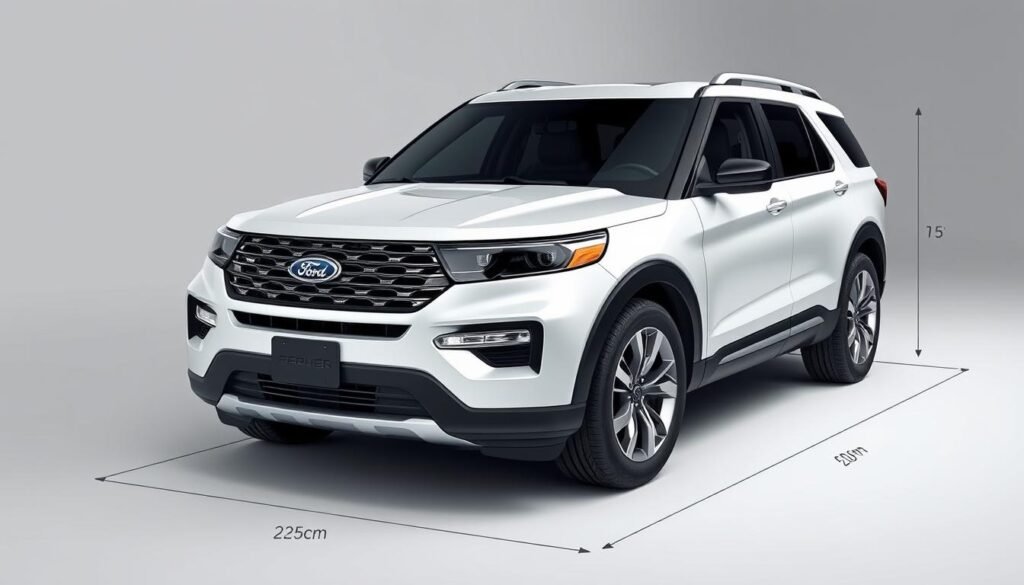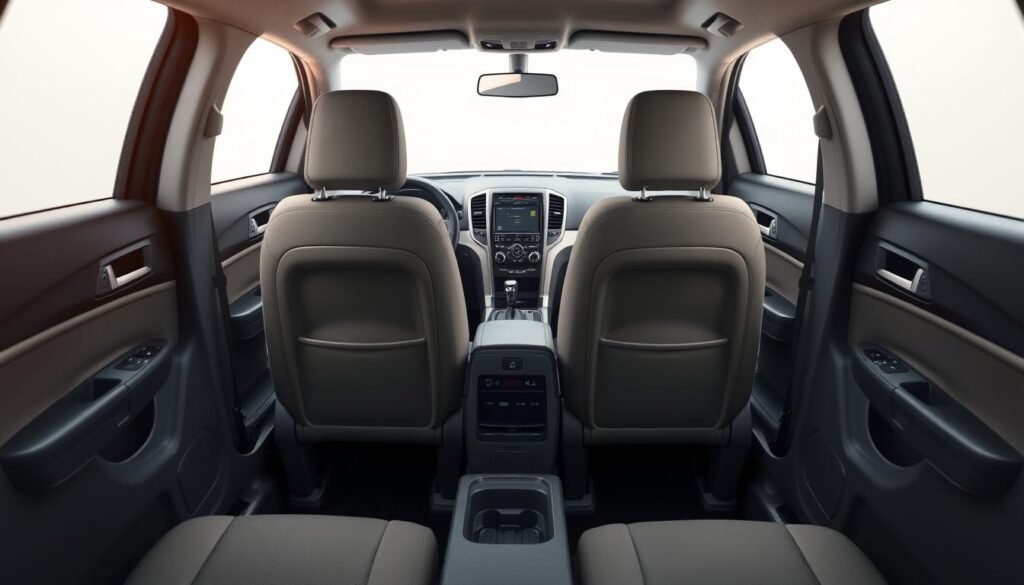What’s Length of Ford Explorer? Dimensions & Specs
The Ford Explorer is 198.3 inches long, or about 16.5 feet. It’s a full-size SUV known for its roomy interior and versatility.
Knowing the Explorer’s dimensions is key for anyone thinking of owning one. These measurements affect how you drive and use the vehicle every day.
Whether you’re planning family trips or daily commutes, the Explorer’s length matters. It ensures comfort and practicality.
In this section, we’ll look at the Explorer’s specs and how they impact your experience.
You’ll learn about its exterior and interior dimensions and how it compares to other Ford SUVs.
Ready to discover why the Explorer is a great choice for you? Let’s dive into its dimensions!
What is The Ford Explorer?
The Ford Explorer has made a big impact in the SUV world. It started in 1990 as a replacement for the Bronco II.
Each new version has brought better design, tech, and safety, meeting what people want and need.
Over time, the Explorer has grown from a tough utility vehicle to a family SUV. By 2020, it was the top SUV in the US.
Its strong build and roomy inside make it a hit with families and those who love the outdoors. It’s known for its safety features, tech, and how well it handles different roads.
The Explorer’s appeal to many shows Ford’s dedication to making great cars. It blends modern looks with useful features, keeping its place in the car world.
Importance of Dimension and Specifications
Knowing how dimensions affect a vehicle’s performance is key. This is true for the Ford Explorer. The dimensions shape the SUV’s look and feel. They also impact how it drives.
A car’s length, width, height, and wheelbase work together. They affect how the car handles, speeds up, and rides smoothly.
How Dimensions Affect Performance?
The Ford Explorer’s wheelbase is 112.8 inches. This length helps with stability and traction. A longer wheelbase means a smoother ride, less feeling bumps in the road.
Driving the Explorer, you’ll see it handles well on and off the road. Its dimensions help it stay in control, making driving safer.
Usability of Dimensions in Everyday Life
The Explorer’s dimensions are more than just numbers. They affect how you use the vehicle every day. The inside space is big, making trips comfortable for everyone.
When you know the Explorer’s size, you can park better. It fits in tight spots, making your life easier. This knowledge helps you choose a vehicle that fits your lifestyle.

Length of Ford Explorer: Essential Specifications
The Ford Explorer is perfect for families who need a lot of space. It’s 198.3 inches long, making it very roomy. This size is great for both passengers and the driving experience.
Looking at the SUV’s dimensions, we see how length affects things like turning and parking. A longer car means a wider turning radius.
This is important when you’re in tight spots. Here’s a quick look at the Explorer’s length specs:
| Specification | Measurement |
|---|---|
| Overall Length | 198.3 inches |
| Wheelbase | 119.1 inches |
| Front Overhang | 37.6 inches |
| Rear Overhang | 41.6 inches |
| Turning Radius | 20.6 feet |

Ford Explorer Exterior Dimensions
The Ford Explorer is a stylish SUV that combines looks and function. Its size is key to its practicality, making it great for families and adventurers.
It stands tall at 70 inches and wide at 78.9 inches, looking good on the road and easy to drive in the city.
Overall Size and Practicality
The Ford Explorer’s size makes it very useful. It has lots of room for people and stuff, perfect for trips or outings.
Being big doesn’t just mean more space; it also means it’s stable and fun to drive, on roads or trails.
Ground Clearance and Its Advantages
Ground clearance is important for the Ford Explorer. It has about 8.7 inches of clearance, great for off-roading. This height helps it handle rough terrain and city streets well.
| Dimension | Measurement |
|---|---|
| Height | 70 inches |
| Width | 78.9 inches |
| Ground Clearance | 8.7 inches |
| Length | 198.8 inches |
Ford Explorer Interior Dimensions
The Ford Explorer is built for comfort, with a total passenger volume of 151.7 cubic feet.
This means everyone can travel in style. The Explorer offers plenty of headroom, making it great for families.
Passenger Space Allocation
The Ford Explorer’s design focuses on passenger comfort. Here are some important measurements:
- Front headroom: 41.4 inches
- Second-row headroom: 40.6 inches
- Front legroom: 43 inches
- Second-row legroom: 39 inches
- Hip room in the front: 57.3 inches
- Hip room in the second row: 56.7 inches
Cargo and Utility Space Overview
The Explorer’s interior is not just about comfort. It also offers lots of storage space. The cargo area can hold up to 87.8 cubic feet, perfect for trips or adventures.

Ford Explorer Length Comparison with Other SUVs
When choosing a vehicle, knowing the Ford Explorer’s length is key. It’s longer than the Chevy Traverse and Honda Pilot, making it stand out.
This is important when picking a car. The Explorer is about 198.8 inches long. This gives it more room for passengers and cargo than its rivals.
The Chevy Traverse is longer at 204 inches, and the Honda Pilot is slightly shorter at 196.5 inches. These small differences can make a big difference in daily use.
The table below shows a side-by-side comparison of lengths among these popular SUVs:
| SUV Model | Length (inches) |
|---|---|
| Ford Explorer | 198.8 |
| Chevy Traverse | 204.0 |
| Honda Pilot | 196.5 |
The Explorer’s size offers lots of room inside while being easy to handle outside. These dimensions affect both looks and usefulness.
This makes you think about what you really need in an SUV for your family and lifestyle.

Ford Explorer Size Specifications Across Different Models
The Ford Explorer has grown in size over the years. Each new generation shows how Ford has changed its design to meet today’s needs.
By looking at Ford Explorer generational comparisons, we can see how the car has evolved.
Comparing Multiple Generations
The first Ford Explorer was introduced in 1990. It was about 181 inches long, fitting into the compact SUV market.
Now, the latest models are over 198 inches long. This shows how cars have gotten bigger and more feature-rich over time.
| Generation | Years | Length (inches) |
|---|---|---|
| 1st Generation | 1991-1994 | 181 |
| 2nd Generation | 1995-2001 | 192 |
| 3rd Generation | 2002-2005 | 189 |
| 4th Generation | 2006-2010 | 197 |
| 5th Generation | 2011-2019 | 198 |
| 6th Generation | 2020-Present | 198 |
Variations in Length by Trim Level
Length can also change based on the trim level. For example, the limited and sport trims often have longer wheelbases.
This affects the overall size of the car. Knowing these size specifications by model helps you pick the right Ford Explorer for you.
- Base Model Length: 198 inches
- Limited Trim Length: 198 inches
- Sport Trim Length: 199 inches
Why Dimensions Matter When Choosing A Family SUV?
The size of a family SUV, like the Ford Explorer, is key for comfort on long trips. A good SUV offers lots of room for both people and their stuff.
This makes family trips with the Ford Explorer fun and stress-free. Knowing how to look at dimensions helps you find the right features. These features make your trips better.
Comfort and Space For Family Trips
Comfort is the top priority when picking a family SUV. The right size means:
- More legroom for everyone.
- Seats that fit child safety seats easily.
- Easy access to the back seats.
Big interiors make a big difference on long drives. Families love the Ford Explorer’s design. It gives everyone enough room, making trips more comfortable and less tiring.
Fitting Your Garage: A Practical Consideration
While big interiors are great for comfort, another important thing is how it fits in your space.
Making sure your SUV, like the Ford Explorer, fits in your garage or parking spot is smart. It saves you trouble later.
It’s a good idea to measure your garage before buying. This way, you know your SUV will fit perfectly at home.
Conclusion
The Ford Explorer’s design makes it a top pick for families. Knowing its size is key to seeing if it fits your needs.
It offers roomy interiors and useful exterior features, making it safe and comfortable. Thinking about the Ford Explorer shows it’s a leading SUV.
By looking at its size, you can decide if it’s right for you. It’s great for daily drives or family trips. Considering the Explorer’s dimensions is important.
It affects how well the vehicle performs and fits into your life. The Ford Explorer remains a reliable and flexible choice for drivers.
FAQs
Q: What is the length of the Ford Explorer?
A: The Ford Explorer is 198.3 inches long. That’s about 16.5 feet.
Q: How does the Ford Explorer compare in size to other SUVs?
A: The Explorer is similar in length to the Chevy Traverse and Honda Pilot. It offers more space for passengers and cargo.
Q: What are the Ford Explorer’s exterior dimensions?
A: The Explorer is 70 inches tall and 78.9 inches wide. This makes it spacious inside and easy to handle in the city.
Q: What is the wheelbase of the Ford Explorer?
A: The Explorer’s wheelbase is 112.8 inches. This helps with stability and traction on different surfaces.
Q: How does the size of the Ford Explorer enhance its on-road and off-road capabilities?
A: The Explorer’s size adds to its stability, comfort, and safety. It’s great for driving on roads and off-road adventures.
Q: What is the passenger volume of the Ford Explorer?
A: Inside, the Explorer has 151.7 cubic feet of space. It’s designed for families, ensuring everyone’s comfort.
Q: How do the dimensions affect fuel efficiency in the Ford Explorer?
A: Larger size means more space but can use more fuel. Yet, the Explorer balances size with aerodynamics for better performance.







